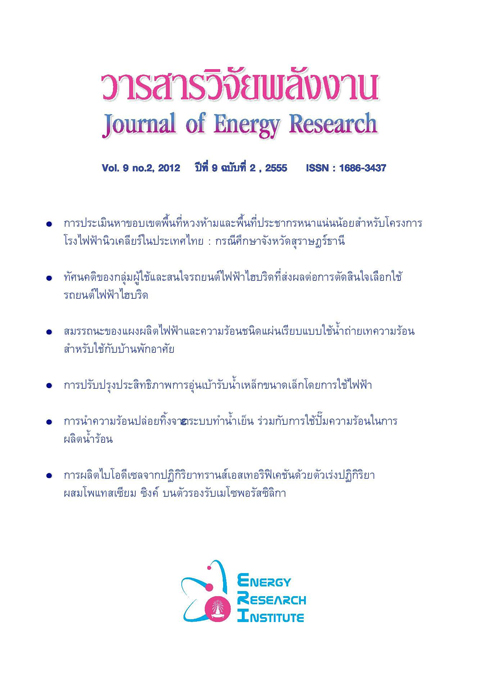การนำความร้อนปล่อยทิ้งจากระบบทำน้ำเย็นร่วมกับการใช้ฮีตปั๊มในการผลิตน้ำร้อน
Main Article Content
Abstract
ในปัจจุบันปัญหาวิกฤตทางด้านพลังงานและสิ่งแวดล้อมเป็นปัญหาหลักที่ได้รับความสนใจจากทุกฝ่าย การใช้พลังงานอย่างมีประสิทธิภาพก็เป็นหนึ่งในแนวทางที่จะช่วยลดปัญหาดังกล่าวได้ โดยเฉพาะอย่างยิ่งการนำความร้อนปล่อยทิ้งกลับมาใช้ให้เกิดประโยชน์ อาคารสำนักงานโดยทั่วไปแล้วจะมีการใช้เครื่องทำน้ำเย็นในการปรับอากาศ ส่งผลให้เกิดความร้อนปล่อยทิ้งซึ่งสามารถนำเอาความร้อนที่ได้กลับมาใช้ในการผลิตน้ำร้อน บทความวิจัยนี้เป็นการศึกษาถึงกระบวนการเพิ่มประสิทธิภาพการใช้พลังงาน โดยการนำความร้อนปล่อยทิ้งจากระบบทำน้ำเย็นในระบบปรับอากาศร่วมกับการใช้ระบบฮีตปั๊มในการผลิตน้ำร้อน ด้วยวิธีการทดลองเก็บข้อมูลจากชุดทดลอง ในการทดลองนั้นได้ทำการควบคุมอัตราการไหลของน้ำที่ไหลเข้าเครื่องแลกเปลี่ยนความร้อน เพื่อหาความสัมพันธ์ที่ส่งผลถึงปริมาณและอุณหภูมิของน้ำร้อนที่ผลิตได้ และศึกษาถึงพฤติกรรมการทำงานของระบบทำน้ำเย็นและฮีตปั๊ม เพื่อใช้เป็นข้อมูลเบื้องต้นในการออกแบบและปรับปรุงระบบจริง และลดปริมาณการใช้พลังงานในการผลิตน้ำร้อนต่อไป ผลจากการทดลอง เมื่ออัตราการไหลของน้ำที่ไหลเข้าเครื่องแลกเปลี่ยนความร้อนมีค่าลดลง อุณหภูมิน้ำร้อนและกำลังไฟฟ้าของเครื่องอัดไอในระบบฮีตปั๊มจะมีค่าเพิ่มขึ้น และในทางตรงกันข้าม เมื่ออัตราการไหลของน้ำมากขึ้น อุณหภูมิของน้ำร้อนและกำลังไฟฟ้าของเครื่องอัดไอในระบบฮีตปั๊มจะมีค่าลดลง ดังนั้นอุณหภูมิของน้ำร้อน จึงขึ้นอยู่กับอัตราการไหลของน้ำ และค่าสัมประสิทธิ์สมรรถนะของระบบฮีตปั๊มจะมีค่าเพิ่มขึ้นจาก 5.01 เป็น 6.39, 6.77, 7.21, 7.56 และ 7.66 คิดเป็น 27.5%, 35.1%, 43.9%, 50.9% และ 52.9% ที่อัตราการไหลของน้ำร้อนเท่ากับ 4, 6, 8, 10, 12 และ 15.5 ลิตรต่อนาทีตามลำดับ โดยที่ระบบทำความเย็นมีค่าสัมประสิทธิ์สมรรถนะเฉลี่ยอยู่ที่ 3.60
Reclaiming heat from water chiller system with heat pump system to produce hot water
WISIT CHUPRASERT and CHITTIN TANGTHIENG
Department of Mechanical Engineering, Faculty of Engineering, Chulalongkorn University
Nowadays energy and environmental crisis are a major concern for all parts of society. One of the solutions to solve this crisis is to use energy efficiently, especially by using a waste heat recovery system. Most office buildings use chillers for cooling whereas the waste heat is obtained as a by-product which can be used in the recovery system to generate hot water.
This paper is the study of the improvement of energy efficient usage by using the waste heat recovery system on the chiller used for an air-conditioning unit with heat pump to generate hot water. This will be performed by collecting data from the experiment conducted by varying the water flow rate as the effect on hot water production. In addition, these results can be applied to other office buildings as a guideline for a preliminary study and design before introducing an actual implementation to reduce energy consumption of the hot water generating system.
The results show that the temperature of produced hot water depends on the water flow rate. When the water flow rate decreases, temperature of hot water and power of heat pump compressor increase. On the other hand, the hot water temperature and power consumptions of heat pump compressor decrease, when the water flow rate is increased. The coefficient of performance (COP) of the chiller with the waste heat recovery system is approximately 3.60 and the coefficient of performance (COP) of the heat pump increased from 5.01 to 6.39, 6.77, 7.21, 7.56 and 7.66 (27.5%, 35.1%, 43.9%, 50.9% and 52.9%) at water flow rate of 4, 6, 8, 10, 10 and 15.5 liters per minute respectively.

